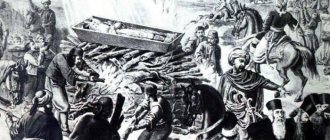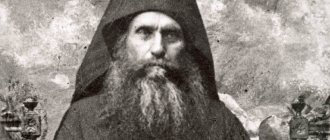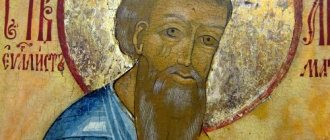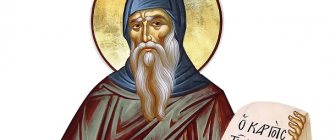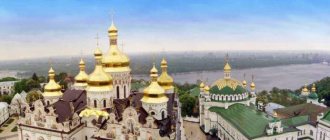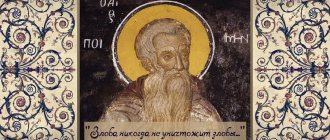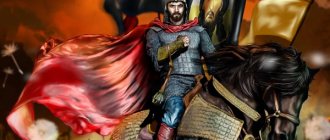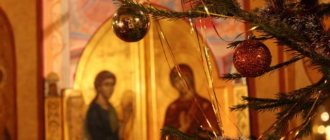| St. Savva the Sanctified |
Savva the Consecrated
(439 - 532), abbot, venerable Memory: December 5 on the day of his death, October 13 on the day of the return of the relics from Italy to the Holy City (ROCOR [1])
Born in 439 in the small town of Mutalaska in Cappadocia into the pious Christian family of John and Sophia. His father was a military leader. Having left for Alexandria on business, he took his wife with him, and left his five-year-old son in the care of his uncle. When the boy was eight years old, he entered the nearby monastery of St. Flavian. The gifted child soon learned to read and studied the Holy Scriptures well. In vain did the parents persuade Saint Sava to return to the world and marry.
At the age of 17, he took monastic vows and was so successful in fasting and prayer that he was awarded the gift of miracles. After spending ten years in the Flavian monastery, the monk went to Jerusalem and entered the monastery of Passarion the Great in Palestine.
Providence soon brought him together with the Monk Euthymius the Great, but he sent Saint Sava to Abba Theoktistus, abbot of the nearby Mucellik monastery with a strict cenobitic charter.
After the death of Elder Theoktistus, his successor blessed the Monk Savva to seclude himself in a cave: only on Saturday did the saint leave the seclusion and come to the monastery, participate in divine services and eat food. After some time, the monk was allowed not to leave the seclusion at all, and Saint Sava labored in the cave for 5 years.
The Monk Euthymius the Great closely followed the life of the young monk and, seeing how he had grown spiritually, began to take him with him to the Ruv desert near the Dead Sea. They left on January 14 and stayed there until the Week of Vai. The Monk Euthymius called Saint Sava a youth-elder and carefully raised him in the highest monastic virtues.
When in 473 the Monk Euthymius the Great departed to the Lord, Saint Sava left the Lavra and settled in a cave near the monastery of the Monk Gerasim of Jordan (+ 475). A few years later, disciples began to gather to the Monk Savva - all those who wanted a monastic life. According to instructions from above (through a pillar of fire), the monks built a church in the cave. This is how the Great Lavra arose in 484. The Lavra was and still serves as one of the centers of Orthodoxy in the East, providing both material assistance and possible education to the surrounding poor Orthodox population.
The Monk Savva founded a total of seven monasteries. Many miracles were revealed through the prayers of the Monk Sava: a spring gushed out in the Lavra, heavy rain fell during a drought, healings of the sick and demon-possessed took place.
At the end of his life, he was sent by Saint Peter of Jerusalem to Emperor Justinian, so that the king would erect a hospital and complete the construction of the New Church in Jerusalem. The emperor agreed and generously presented Saint Sava with funds for the improvement of the Lavra.
Compiled the “Liturgical Rules” (Typik), also known as the Jerusalem Rules.
Died on December 5, 532.
The life of Saint Sava is described by his contemporary Cyril of Scythopolis [2].
In 1256, his incorrupt relics were transported to Venice and buried in the Church of San Antonio, and on October 26, 1965, returned back to the Lavra he founded. They are to this day located there in the Church of the Virgin Mary near the southern wall [3], and numerous cases of healing occur from them.
Used materials
- Encyclopedic Dictionary of Brockhaus and Efron:
- Life on the website Pravoslavie.Ru
- Klevtsova Elena, “Visiting Savva the Sanctified,” 18.12.2005:
[1] Trinity Orthodox Russian Calendar for 2022 - Holy Trinity Monastery. Tѵpografїѧ Ave. Іωва Pochaevskagω in Jordanville, 2022, p. 138, .
[2] see ed. Cotelerius, P., 1661
[3] Venerable Savva the Sanctified // Iveron Candle: Parish leaflet of the Church of the Iveron Icon of the Mother of God, Palanga. — 2009, No. 19 (Issue No. 241), p. 12, — viewing static pages in the built-in player (unstable; mirror: ); Memory of the Venerable Savva the Sanctified // Synaxarion. Lives of the Saints of the Orthodox Church. Author-compiler: Hieromonk Macarius of Simonopetra. Adapted translation from French. In 6 vols. - M.: Sretensky Monastery Publishing House, 2011. - T. II. — P. 467, .
Venerable Savva the Sanctified, Mutalask, abbot
The Monk Savva the Sanctified was born in the 5th century in Cappadocia, into the pious Christian family of John and Sophia. His father was a military leader. Having left for Alexandria on business, he took his wife with him, and left his five-year-old son in the care of his uncle. When the boy was eight years old, he entered the nearby monastery of St. Flavian. The gifted child soon learned to read and studied the Holy Scriptures well. In vain did the parents persuade Saint Sava to return to the world and marry.
At the age of 17, he took monastic vows and was so successful in fasting and prayer that he was awarded the gift of miracles. After spending ten years in the Flavian monastery, the monk went to Jerusalem, and from there to the monastery of St. Euthymius the Great. But the Monk Euthymius (January 20) sent Saint Sava to Abba Theoktistus, the abbot of a nearby monastery with strict cenobitic rules. The Monk Savva remained in that monastery as a novice until he was 30 years old.
After the death of Elder Theoktistus, his successor blessed the Monk Savva to seclude himself in a cave: only on Saturday did the saint leave the seclusion and come to the monastery, participate in divine services and eat food. After some time, the monk was allowed not to leave the seclusion at all, and Saint Sava labored in the cave for 5 years.
The Monk Euthymius closely followed the life of the young monk and, seeing how he had grown spiritually, began to take him with him to the Ruv desert (near the Dead Sea). They left on January 14 and stayed there until Vai Week. The Monk Euthymius called Saint Sava a youth-elder and carefully raised him in the highest monastic virtues.
When the Monk Euthymius departed to the Lord († 473), Saint Sava left the Lavra and settled in a cave near the monastery of the Monk Gerasim of Jordan († 475; commemorated March 4). A few years later, disciples began to gather to the Monk Savva - everyone who wanted a monastic life. This is how the Great Lavra arose. According to instructions from above (through a pillar of fire), the monks built a church in the cave.
The Monk Savva founded several more monasteries. Many miracles were revealed through the prayers of the Monk Sava: a spring gushed out in the Lavra, heavy rain fell during a drought, healings of the sick and demon-possessed took place. The Monk Savva wrote the first charter of church services, the so-called “Jerusalem”, accepted by all Palestinian monasteries. The saint peacefully reposed before God in 532.
See also: “The Life and Deeds of St. our father Savva the Sanctified" as presented by St. Demetrius of Rostov.
Venerable Savva the Sanctified
The numerous shrines of the Holy Land are visited annually by thousands of pilgrims from different countries, especially from Russia. But there is one place in Jerusalem that, completely undeservedly, does not receive much attention from pilgrims. Largely due to its inaccessibility, since it is impossible to get to this place by tourist bus, only by car.
We are talking about the Lavra of St. Sava. Access to the monastery is only possible for men, who, if desired, can even stay there for a while to participate in monastic life. This is the second reason for the low attendance at the monastery.
The Monk Sava came to this now holy place from Cappadocia in search of prayerful solitude. Gradually, his numerous followers began to flock to him, and in 484 the Lavra was founded. Nowadays the monastery is a place completely detached from the world, where there is no electricity or cellular communications, but God’s grace is abundantly poured out here through the prayers of St. Savva.
On December 18, the Holy Church honors the memory of this wondrous saint, the Venerable Savva the Sanctified, who strove and sought the Kingdom of God with all his mind and heart. Here is an excerpt from the life of St. Savva the Sanctified, recorded by the monk Cyril of Scythopolis, who lived in the Lavra from 555 until his death.
Abba , this earthly angel and heavenly man, was a wise and skillful teacher, defender of Orthodoxy, and a prudent steward. He, by the goodwill of God the Father, with the assistance of Christ and by the inspiration of the Holy Spirit, populated the desert with many monks and founded seven glorious monasteries in it. Having care and concern for these monasteries, he did not want to acquire anything for the future and, strengthened by his trust in God, never indulged in this care. This was especially evident during the famine. Then our holy father Savva inspired the abbots of his monasteries not to care at all about carnal things and reminded them of the following words of the Lord: “Do not worry, saying: what shall we eat? or what to drink? or what to put on?.. Seek first the Kingdom of God... and all these things will be added to you” (Matthew 6:31,33). This is how this divine elder thought and taught. God gave him abundantly all the necessary things, so that those who relied on their money suffered more from shortages than the monasteries he ruled.
During this famine, the steward of the Great Lavra came to Savva and said: “This coming Sunday, Father, I cannot call you to the liturgy, because we have nothing.” The elder said to him: “I don’t want to cancel the services, for He is faithful who said: “Do not worry about tomorrow” (Matthew 6:34).” The next day, the Sozov innkeepers arrived from the Holy City and, on thirty horses, brought a large amount of food to the Lavra, and filled the pantry with all sorts of supplies. Then the elder, reproaching the steward, said: “Why did you say: there is no need to gather the fathers, because there is no food for them? Never doubt, but, strengthened by faith, cast all your care on God, for He cares for us.”
The Monk Sava the Sanctified exudes numerous miracles. Cancer patients receive healing, and spouses without children become parents. In ancient times, a date tree grew in the Lavra, the fruits of which healed the infertility of spouses. This tree dried up shortly before the relics of St. Petersburg were returned to the Lavra in 1965. Savva. After this, they began to give pilgrims only pieces of dried wood for blessing. More recently, it has sprouted again: a small tree has grown on the old root, its leaves have the same properties: they heal infertility. They are brewed and drunk like tea.
Saint Sava does not leave those who firmly believe in his heavenly intercession in any need.
Two brothers owned a vineyard and often gave shelter to brothers who came to them from the Lavra of St. Savva. At the very time of the grape harvest, they fell ill with some serious illness, so they despaired of getting both wine and staying alive. But they believed in the heavenly intercession of St. Savva and often remembered him, calling for help. The saint soon heard their prayer, appeared to each of them separately and said: “I prayed to God for your health, and He gave it to you at your request; get up and go to work."
Having come to their senses, they felt healthy, glorified God and thanked the saint
Troparion (a short prayer rule about the holiday, in which the commemorated saint is also glorified and called to help)
From your forests, through the streams of the desert, you cultivated the fruitless, / and from the depths of your sighs, you bore fruit for a hundred labors, / and you were the lamp of the universe, shining miracles, Savvo our Father, / / pray Christ God may save our souls.
Reverend Theodosius the Great
Icon of Savva Storozhevsky
The saint came to the Holy Trinity Monastery, founded by St. Sergius of Radonezh, a very young man. His date of birth and family are unknown - there are suggestions that he was the son of a boyar from Smolensk. Having gone through the usual labors and tests, he was tonsured a monk by Saint Sergius himself. Like all the inhabitants of the Sergius monastery, he worked a lot - carried water, built temples and cells, tended the monastery's garden - and also performed ascetic feats of fasting, vigil and prayer . The brothers and the abbot loved Savva for his many virtues, meekness and humility, and always a peaceful state of mind. He fell in love with monastery services and was always the last to leave the church, and for solitary prayer he chose a ravine not far from the monastery. Now there is a spring nearby that bears his name.
Over time, the saint was ordained as a priest and appointed by the abbot of the monastery himself, St. Sergius, to be the confessor of the brethren and also to confess to the laity who came to the monastery to pray. In every monastery this is the most important role and great spiritual responsibility. Saint Sava's advice was filled with God's grace and edification.
Considering Savva ready for an independent life and exploits, the Monk Sergius blessed him to become the abbot of the Assumption Monastery on the Dubinka River, founded by the holy Prince Dmitry Donskoy in gratitude to God for the victory on the Kulikovo Field. In 1392, after the death of St. Sergius of Radonezh and the retirement of the elderly Saint Nikon of Radonezh, successor of St. Sergius, into seclusion (acceptance of the feat of solitary prayer), the brethren of the monastery begged the Monk Savva to become the rector of the Trinity-Sergius Lavra (then bearing the name of a simple monastery). He remained in this post for about six years.
In 1399, Prince of Zvenigorod Yuri Dimitrievich, who was the godson of St. Sergius, asked St. Savva to become his confessor and settle in his domain, founding a monastery there. Leaving the Trinity-Sergius monastery in the care of his disciples, the saint went to the deserted Storozheva Mountain, founding there a temple in honor of the Nativity of the Most Holy Theotokos and a small cell. The prince visited the saint there, asking for blessings on important matters of government - thus, the saint blessed Yuri for victorious campaigns against the Tatars (in Volga Bulgaria, in Kazan). Over time, the prayer of the Storozhevsky elder helped preserve Rus' during the invasion of Tamerlane. The Monk Savva predicted victory, and his insightful words came true.
Over time, brethren also appeared in the Storozhevsky Monastery. Despite his old age, Saint Sava worked here too in the construction of churches and dwellings for the brethren. He died peacefully in 1407, at a very old age, having given instructions to the brethren before his death. The Church canonized him as a venerable ascetic of God a hundred years later.
Alas, after the death of the saint, the descendants of Prince Yuri and his brothers began internecine warfare, so the Zvenigorod monastery fell into temporary decline.
